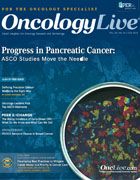Publication
Article
Oncology Live®
West Coast Study Rates Cancer Centers by Cost and Quality
Author(s):
In a groundbreaking study of costs and quality of cancer care among cancer clinics in the state of Washington, investigators found wide disparity in end-of-life care, suggesting that improvements in cost and quality could be attained if treatment centers share information on what works and endeavor to improve.
Scott Ramsey, MD, PhD, associate professor of oncology and urology at Johns Hopkins Medicine

Scott Ramsey, MD, PhD
In a groundbreaking study of costs and quality of cancer care among cancer clinics in the state of Washington, investigators found wide disparity in end-of-life care, suggesting that improvements in cost and quality could be attained if treatment centers share information on what works and endeavor to improve. Smaller but also significant differences were noted in measures of care for patients with breast cancer and in the management of chemotherapy in general for breast, colorectal, and lung cancers.
Table. Key Comparative Measures for Cancer Clinics in Study
ED indicates emergency department; ER, estrogen receptor; ICU, intensive care unit; PR, progesterone receptor.
aRanges have been risk-standardized for patient factors and clinic size.
bThe measure included patients who had a test for cancer antigen (CA) 15-3, CA 27.29, or carcinoembryonic antigen. These tumor markers have not been proven useful to find breast cancer recurrence or extend life in patients who had early-stage breast cancer.
The report is unique because it involved agreement among 27 participating clinics in Washington to publicly disclose findings on comparative costs and quality of cancer care. In some cases the disparities in care and conformance with guidelines were wide. In particular, the report called for improvements in management of emergency department (ED) and inpatient stays, which were high among patients receiving chemotherapy.The study was conducted by the Hutchinson Institute for Cancer Outcomes Research (HICOR), based at Fred Hutchinson Cancer Research Center in Seattle, Washington. The goal behind disclosuring the results was to encourage collaboration to identify ways that practices can improve and initiate change. “I believe strongly that better transparency will ultimately improve care and [hopefully] lower costs for patients,” Scott Ramsey, MD, PhD, director of HICOR, said in a statement.
Although wide variations in costs of care were noted among the clinics (Table), some of the variations could be explained by location, such as whether care was delivered in a hospital or an independent clinic. In other cases, a “biopsy” would be needed to fully determine the reasons for discrepancy, the HICOR report said.
The report noted that a large majority (85.6%) of patients received appropriate therapy for treatment of breast, colorectal, and lung cancer, after adjusting for clinic size and patient characteristics. A difference of 3.9 percentage points separated the highest- and lowest-scoring clinics, which the HICOR report described as a “minimal” difference. On average, 98% of patients received the appropriate antinausea drugs during chemotherapy.
Rates of ED visits and inpatient stays were high, on average, during the 6 months after chemotherapy was begun, which the HICOR report said indicated a need for improvement. The report said 29.1% of patients visited the ED at some point during chemotherapy (range, 24.1%-37.1%) and 37.4% had an inpatient stay during chemotherapy (range, 30.9%-44.1%).
Costs of hospitalization during chemotherapy averaged $51,561; the difference between the highest- and lowest-performing clinics was $19,090 (range, $42,758-$61,848). The authors found a strong negative relationship between episode costs and quality scores, indicating that efforts to improve quality may also lower costs during chemotherapy treatment.
End-of-life care metrics revealed the greatest divergence in costs and quality of care, with 61.8 percentage points between the highest- and lowest-performing clinics. The authors reported that clinics that performed better on hospice care tended to have lower rates of chemotherapy, ED visits, and ICU stays.
One-fifth of patients had an ICU stay during the last 30 days of life, with a difference of 26.3 percentage points between the highest- and lowest-scoring clinics, “suggesting considerable differences in how clinics manage intensity of care at the end-of-life stage.”
On average, 62.5% of patients with cancer entered hospice care 3 or more days before death, with a difference of 37.2 percentage points between the highest and lowest scores, which also suggested considerable variation in the way clinics are managing hospice care referrals.
The report said 12.6% of patients with cancer had more than 1 ED visit in the last 30 days of life, with a gap measure of 9.3 percentage points between highest- and lowest-scoring clinics.
Finally, 5.8% of patients received chemotherapy during the final 14 days of life, with a difference of 6.0 percentage points between the extremes on the performance scale.
Adherence to Guidelines
Large differences in score results were also noted among clinics for follow-up care in breast cancer. The regional average cost of care for follow-up testing after breast cancer treatment was $13,978, with a maximum difference between treatment centers of $4219, or 42.1 percentage points. The authors noted a strong negative relationship between episode cost and the quality score, “indicating that higher quality is associated with lower costs.”The HICOR report said that in the 13 months following treatment, 24.1% of patients with breast cancer received tumor marker tests for cancer antigen 15-3, cancer antigen 27.29, or carcinoembryonic antigen. The authors noted a maximum difference of 44.1 percentage points in the rate of tumor marker test orders among clinics. This signified wide variation in practice patterns among sites of care relative to national recommendations, which do not recommend tumor marker testing in follow-up care, the report said.
Differences among centers on breast cancer treatment narrowed when it came to whether patients received the recommended therapy based on estrogen/progesterone receptor and HER2 status. On average, 92% did, and the difference between clinics at the highest and lowest extremes was just 4.1%, which suggested minimal difference in receipt of recommended treatments, the authors said. In general, patients with breast cancer are receiving appropriate therapy in Washington, they noted.
The regional average cost for breast, colorectal, and lung cancer treatment was $71,647, with the average episode lasting 176 days. The margin of difference between lowest- and highest-cost clinics was 7.1 percentage points. Investigators found no difference between episode cost and quality score, “suggesting there may be an opportunity to lower costs without sacrificing quality.”
Data for the HICOR study reflected treatment from 2014 to 2016 and were taken from the Washington State Cancer Registry, Western Washington Cancer Surveillance System, and claims data from most payers in Washington, including Medicare. This information included how much providers were paid for services and drugs but not patient out-of-pocket costs. The data included more than 36,900 patients, representing roughly 70% of the patients with cancer treated in the region.
A large stakeholder inclusion effort preceded the study to ensure participation and a commitment to the goals of the project. Clinics were informed that the comparative data would be made public and that the data were not to be used for marketing or for determining physician or staff compensation or benefits.
“I felt it was imperative that we engage everyone involved, including patients, providers, health systems, and payers, to come up with reasonable approaches to improve the quality of patient care while constraining costs and improving the overall value of what we provide to patients,” said Gary H. Lyman, MD, MPH, co-director of HICOR, in a statement.
Hutchinson Institute for Cancer Outcomes Research. Community Cancer Care in Washington State: Quality and Cost Report 2018. fredhutch.org/en/ labs/hicor/community-cancer-care-report.html. Published May 1, 2018. Accessed July 6, 2018.
























%20(2)%201-Recovered-Recovered-Recovered-Recovered-Recovered-Recovered-Recovered-Recovered-Recovered-Recovered-Recovered-Recovered-Recovered-Recovered-Recovered-Recovered-Recovered.jpg?fit=crop&auto=format)
%20(2)%201-Recovered-Recovered-Recovered-Recovered-Recovered-Recovered-Recovered-Recovered-Recovered-Recovered-Recovered-Recovered-Recovered-Recovered-Recovered-Recovered-Recovered.jpg?fit=crop&auto=format)
